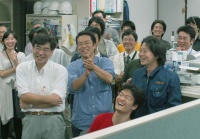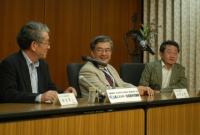 |
 |
|||||||||||||
|
|||||||||||||
|
|||||||||||||
|
This year's Nobel Prize in physics was awarded to a Japanese-born American and two Japanese particle physicists: Yoichiro Nambu, professor emeritus at University of Chicago, for the discovery of the mechanism of spontaneous broken symmetry in subatomic physics, Makoto Kobayashi, professor emeritus at KEK and executive director of the Japan Society for the Promotion of Science, and Toshihide Maskawa, professor at Kyoto Sangyo University in Kyoto, for the discovery of the origin of the broken symmetry which predicts the existence of at least three families of quarks in nature. “I am just happy. Our long-cherished dream comes true,” said Masa Yamaushi, spokesperson for the Belle experiment and member of Funding Agencies for Large Colliders (FALC), at the press conference held at KEK immediately after the announcement of the 2008 Nobel Prize in physics. The Kobayashi-Maskawa model, the theory they published in 1973, is considered the most reasonable theory among many to prove CP (charge-parity) violation. It has become the basis for the standard theoretical explanation of this mechanism of elementary particles and thus for the origin of the Universe. “I am delighted that KEKB accelerator has helped Dr. Kobayashi and Dr. Maskawa to win the Nobel Prize,” said Katsunobu Oide, leader of the KEKB accelerator team. The experiments on CP violation of B meson systems at KEKB have experimentally verified the Kobayashi-Maskawa model. The Nobel Foundation's press release also includes explicit mention of SLAC's BaBar experiment because it helped confirm one of the key predictions. CP violation is related to the asymmetry between matter and antimatter in the Universe. However, new physics beyond the standard model, such as SUSY or Extra Dimensions have not been discovered yet. “This is just the beginning,” said Atsuto Suzuki, the Director General of KEK, “We would like to step forward with more powerful accelerators such as an upgraded KEKB and the International Linear Collider in order for Japan to become one of the leading countries in this field of study.” -- Rika Takahashi Read the Nobel Prize press release |
|||||||||||||
| © International Linear Collider |


